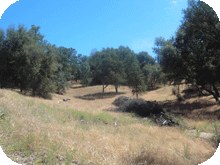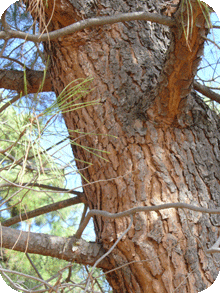
This mailer has been provided as an avenue to disperse information pertinent to public agencies and the landscape architecture profession in hopes of fostering greater understanding and collaboration. Topics address issues that affect the built environment within which we live.
Benefits and Sustainainable Features of our Urban Forests
"I never before knew the full value of trees. Under them I breakfast, dine, write, read, and receive my company." Thomas Jefferson.
Most people would agree that picnicking or reading under a large shade tree on a warm spring afternoon is pleasant. Most people would also agree that trees provide a unique aesthetic appeal to the landscape and provide necessary habitat for wildlife. These are all societal benefits of trees that are generally understood but are difficult to quantify. The purpose of this issue is to bring to the forefront, benefits of trees that do not readily come to mind and that can be scientifically quantified. Studies have shown the following benefits can be achieved through the addition of trees to the urban forest:
Temperature Regulation and Energy Conservation
- Up to 20° F lower temperatures on sites with trees.1
- Up to 35° F lower surface temperatures on pavement shaded with trees.1
- Up to 2° F lower air temperatures in 30% shaded parking lots.3
- Up to 26° F lower temperatures in parked car cabins shaded with trees.3
- Up to 7° F lower fuel tank temperatures in parked cars shaded with trees.3
- Up to 7% reduction in energy for winter heating.1
- Up to 50% wind speed reductions.1
Air Quality
- .8 metric ton/day (tpd) reduction of emissions in a typical parking lot with 50% canopy cover.3
- Up to 60% reduction in street level pollution.1
- Average of 13 pounds of annually stored carbon per tree.1
- One acre of trees generates sufficient oxygen each day for 18 individuals.1
Water Quality
- Up to 22% of winter precipitation utilized by trees.1
- Up to 18% of growing season precipitation utilized by trees.1
- Up to 2% reduction in runoff for every additional 5% tree cover added to a city.1
Noise Abatement
- Decrease in sound of 6-15 decibels with plantings ranging from 100 ft. of forest to combinations of understory vegetation, trees and land forms.4
Economic
- Possible savings of up to 58% on life of streets due to shade cover.2
- 10 to 25 year street re-pavement deferment on shaded streets.2
- 80% higher comfort and amenity ratings in retail districts with trees.5
- 30% higher product quality ratings in retail districts with trees.5
- 15% higher service ratings in retail districts with trees.5
- 12% spending increase in retail districts with trees.5
- Documented increase of shopper willingness to travel longer distances, stay longer, visit more often and pay more for parking in retail districts with trees.5
- 1-9% property value increase on properties with trees.4
- Average net value to community of public trees is $48 per tree/year.4
These examples are just a few of the many benefits trees provide. Trees are not the answer to all of our society's problems; however, they can certainly be on of the most effective, consistent and beautiful tools we use to help us get where we want to be. If this subject matter interests you, the following two sites are great resources for further research in the fields of landscape architecture and arboriculture.
http://www.fs.fed.us/psw/programs/cufr/
http://www.ufei.org/resources.lasso
1. Coder, Rim, D., 1996. Identified Benefits if Community Trees and Forests. University of Georgia.
2. McPherson, E.G., J. Muchnick. 2005. Effects of Street Tree Shade on Asphalt Concrete Pavement Performance. Journal of Arboriculture. 31(6) :303-310
3. McPherson, E.G., J.R. Simpson and K.I. Scott. 2001. Actualizing microclimate and air quality benefits with parking lot tree shade ordinances. Wetter und Leben. 4(98) :353-369 .
4.McPherson, E.G., J.R. Simpson, P.J. Pepper and Qingfu Xiao.1999. Tree Guidelines for San Joaquin Valley Communities. Western Center for Urban Forest Research and Education, USDA Forest Service.
5. Wolf, Kathleen L., 1999. Nature And Commerce: Human Ecology in Business Districts. Building Cities of Green: Proceedings of the 9th National Urban Forest Conference. D.C. American Forests
The next time you need a Landscape Architect on your project, consider O'Dell Engineering's Landscape Architecture Department.
Services include:
- Park and Playground Design
- Recreational Facility Design
- Site Planning
- Streetscape Design
- Urban Design
- Commercial Design
- 3-D Visualizations
- Graphic Design
- Arborist Consulting



Author: Chad Kennedy, Landscape Architect
This informational article provided by O'Dell Engineering - 1165 Scenic Drive, Suite A, Modesto CA 95350
